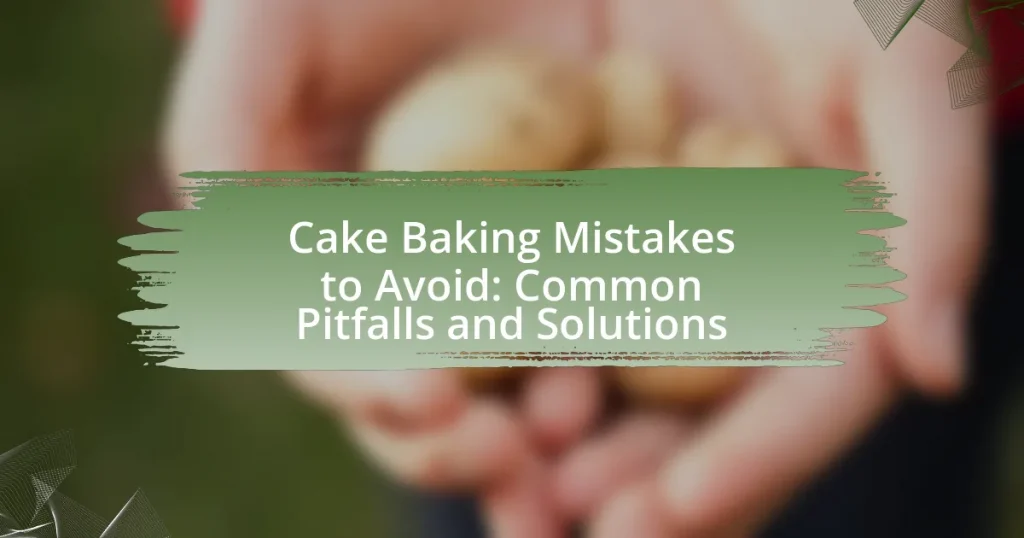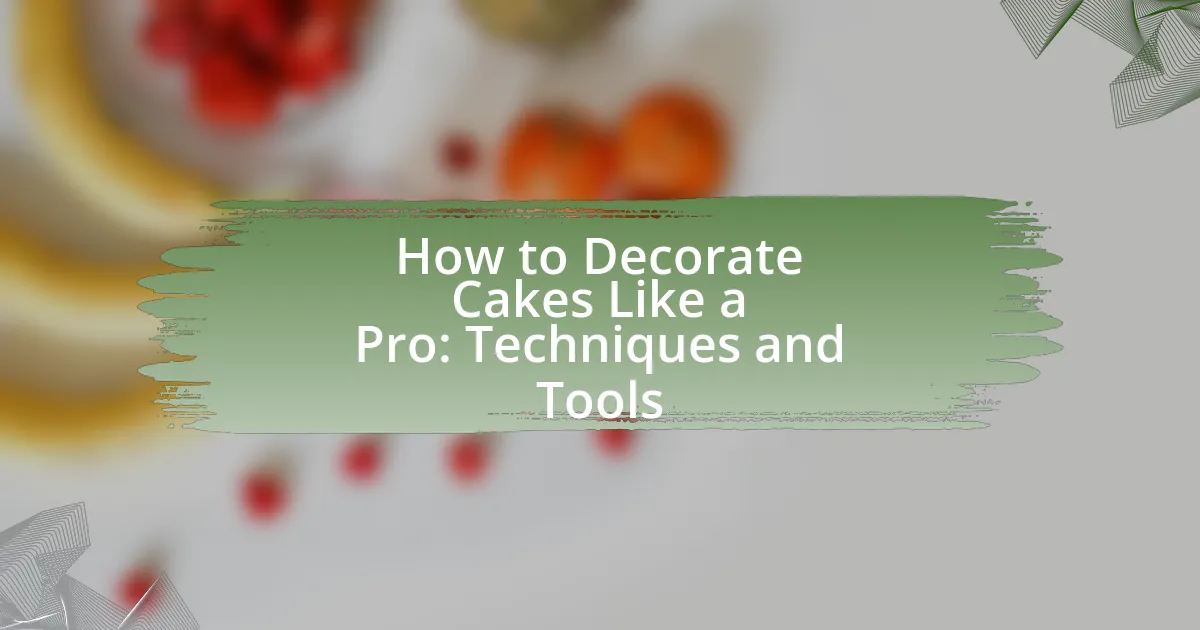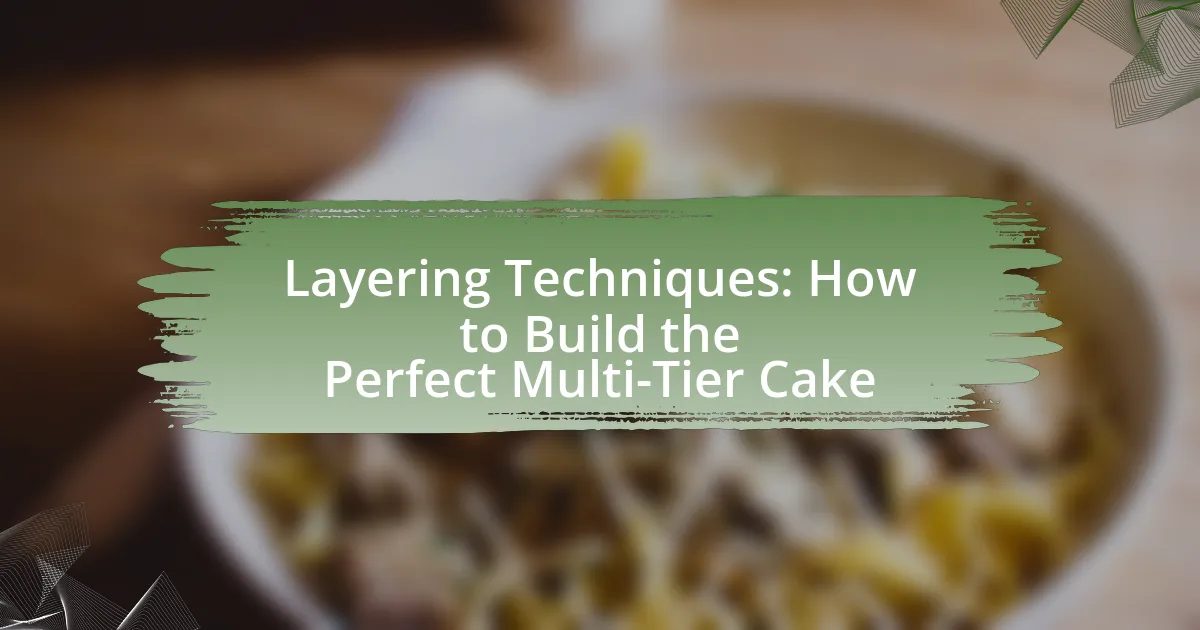The article focuses on common cake baking mistakes and offers solutions to avoid them. Key pitfalls include inaccurate ingredient measurements, improper oven temperature, and insufficient mixing techniques, all of which can negatively impact the cake’s texture and flavor. The importance of identifying these mistakes is emphasized, as it allows bakers to enhance their skills and achieve consistent results. Additionally, the article provides practical tips for troubleshooting issues, ensuring accurate measurements, and following best practices to improve overall baking outcomes.
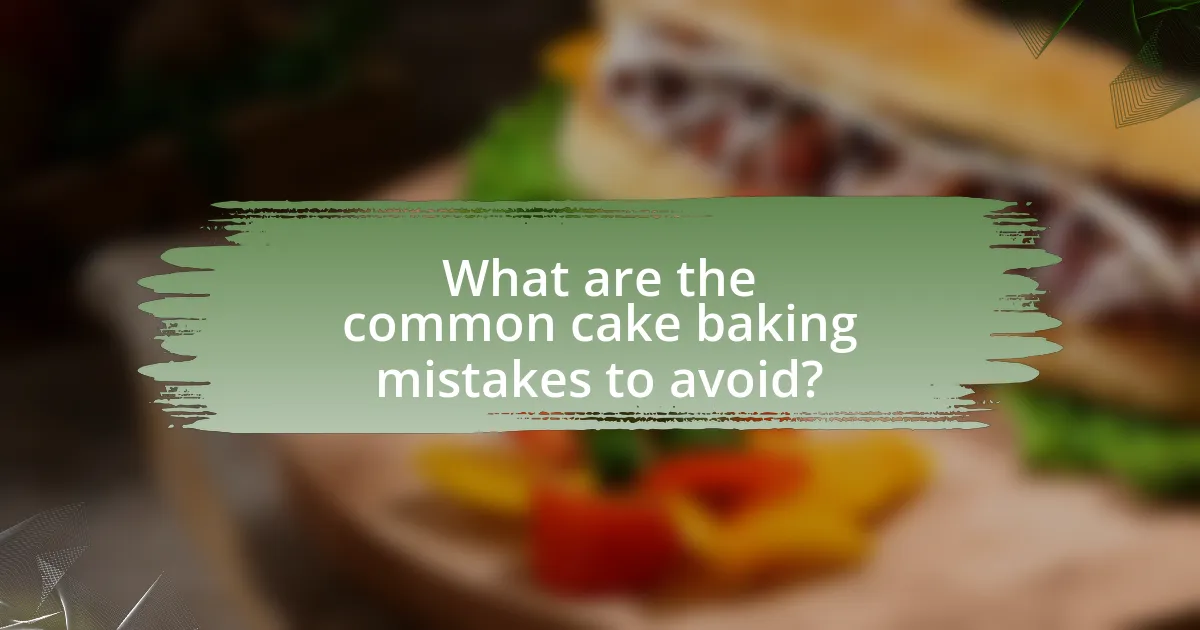
What are the common cake baking mistakes to avoid?
Common cake baking mistakes to avoid include not measuring ingredients accurately, which can lead to imbalanced flavors and textures. For instance, using too much flour can result in a dry cake, while too little can cause it to collapse. Another mistake is not preheating the oven, which affects the cake’s rise and texture; cakes should be baked in a properly heated oven to ensure even cooking. Additionally, opening the oven door too frequently during baking can cause temperature fluctuations, leading to uneven baking. Lastly, underbaking or overbaking the cake can ruin its texture; cakes should be tested for doneness with a toothpick, which should come out clean or with a few crumbs attached.
Why is it important to identify cake baking mistakes?
Identifying cake baking mistakes is crucial for achieving consistent and desirable results in baking. When bakers recognize errors such as incorrect ingredient measurements, improper mixing techniques, or inadequate baking times, they can adjust their methods to improve the final product. For instance, a study published in the Journal of Culinary Science & Technology highlights that precise measurements and techniques significantly impact the texture and flavor of baked goods. By understanding and correcting mistakes, bakers enhance their skills, reduce waste, and ultimately create cakes that meet their expectations.
How can recognizing mistakes improve baking skills?
Recognizing mistakes can significantly improve baking skills by enabling bakers to identify and correct errors in their techniques and recipes. When bakers analyze their failures, such as a cake not rising or uneven baking, they can pinpoint specific issues like incorrect ingredient measurements or improper oven temperatures. This reflective practice fosters a deeper understanding of baking science, allowing bakers to adjust their methods accordingly. Studies show that learning from mistakes enhances skill acquisition, as it encourages critical thinking and problem-solving, which are essential in mastering baking.
What impact do mistakes have on the final cake quality?
Mistakes during cake baking significantly degrade the final cake quality. Common errors, such as incorrect ingredient measurements, improper mixing techniques, or inadequate baking times, can lead to issues like uneven texture, poor rise, or undesirable flavors. For instance, using too much flour can result in a dense cake, while underbaking can leave the center gooey. These mistakes directly affect the cake’s appearance, taste, and overall enjoyment, demonstrating that precision and attention to detail are crucial for achieving a high-quality cake.
What are the most frequent pitfalls in cake baking?
The most frequent pitfalls in cake baking include inaccurate measurements, improper oven temperature, and insufficient mixing. Inaccurate measurements can lead to imbalanced ingredients, resulting in a dense or dry cake. For example, using a cup measurement instead of weighing ingredients can cause discrepancies, as flour can be packed differently. Improper oven temperature affects baking time and texture; an oven that is too hot can cause the cake to rise too quickly and then collapse, while one that is too cool can lead to undercooked centers. Insufficient mixing can prevent proper incorporation of air, leading to a dense texture instead of a light and fluffy cake. These pitfalls are commonly cited in baking literature, emphasizing the importance of precision and technique in achieving successful results.
How does incorrect ingredient measurement affect baking?
Incorrect ingredient measurement negatively impacts baking by altering the chemical reactions necessary for proper texture and flavor. For instance, too much flour can lead to a dense cake, while insufficient sugar may result in a lack of sweetness and poor browning. Accurate measurements are crucial because baking is a science; even slight deviations can cause significant changes in the final product. Studies show that precise ingredient ratios are essential for achieving the desired rise and moisture in baked goods, underscoring the importance of correct measurements in successful baking.
What role does oven temperature play in cake baking mistakes?
Oven temperature is crucial in cake baking, as incorrect temperatures can lead to various baking mistakes. When the oven is too hot, cakes may rise rapidly and then collapse, resulting in a dense texture. Conversely, if the oven temperature is too low, cakes may not rise adequately, leading to a heavy and undercooked product. Research indicates that maintaining a consistent temperature, typically around 350°F (175°C) for most cakes, is essential for even baking and achieving the desired texture. Therefore, precise oven temperature control directly impacts the success of cake baking.
Why is mixing technique crucial in cake preparation?
Mixing technique is crucial in cake preparation because it directly affects the cake’s texture and structure. Proper mixing ensures that ingredients are evenly combined, which promotes the formation of a stable batter that can trap air, leading to a light and fluffy cake. For instance, over-mixing can result in a dense and tough cake due to excessive gluten development, while under-mixing can lead to uneven distribution of ingredients, causing inconsistencies in texture. Therefore, mastering the mixing technique is essential for achieving the desired cake quality.
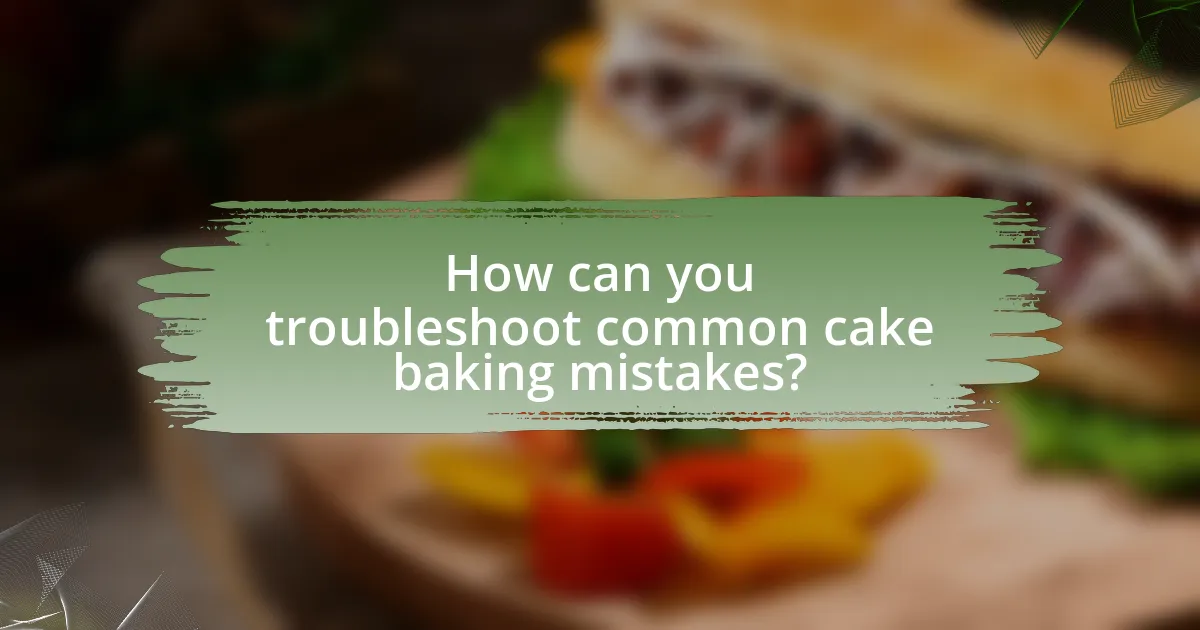
How can you troubleshoot common cake baking mistakes?
To troubleshoot common cake baking mistakes, first identify the specific issue, such as a cake that is too dry, too dense, or not rising properly. For a dry cake, ensure that the correct amount of liquid ingredients is used and avoid overbaking, as cakes typically require precise baking times to retain moisture. If the cake is too dense, check that the leavening agents, like baking powder or baking soda, are fresh and properly measured, as expired agents can prevent the cake from rising. For cakes that do not rise, verify that the oven temperature is accurate, as an oven that is too hot or too cold can significantly affect the cake’s structure. Additionally, ensure that ingredients are mixed correctly; overmixing can lead to a tough texture, while undermixing can result in uneven distribution of ingredients. These troubleshooting steps are based on established baking principles that emphasize the importance of ingredient ratios, mixing techniques, and baking conditions.
What solutions exist for ingredient measurement errors?
Solutions for ingredient measurement errors include using digital kitchen scales for precise weight measurements, employing standardized measuring cups and spoons for volume, and utilizing measuring tools designed for specific ingredients, such as liquid measuring cups for liquids and dry measuring cups for solids. Digital scales provide accuracy to the gram, which is crucial in baking, as even slight variations can affect the final product. Standardized measuring tools help ensure consistency across different recipes, reducing the likelihood of errors. Additionally, following ingredient-specific guidelines, such as spooning flour into a measuring cup rather than scooping, can further minimize measurement inaccuracies.
How can you ensure accurate measurements in baking?
To ensure accurate measurements in baking, use a digital kitchen scale for weighing ingredients instead of relying on volume measurements. This method provides precision, as weight is a more consistent measure than volume, which can vary based on factors like ingredient packing and humidity. For example, one cup of flour can weigh anywhere from 120 to 150 grams depending on how it is scooped. Using a scale eliminates this variability, leading to more reliable baking results.
What tools can help with precise ingredient measurement?
Digital kitchen scales are essential tools for precise ingredient measurement in baking. They provide accurate weight readings, allowing bakers to measure ingredients like flour, sugar, and butter with high precision, which is crucial for achieving consistent results in cake baking. Studies show that using weight rather than volume can improve recipe accuracy, as ingredients can vary in density. For example, a cup of flour can weigh anywhere from 120 to 150 grams depending on how it is packed. Therefore, digital kitchen scales eliminate this variability, ensuring that bakers use the exact amount needed for their recipes.
How can you adjust for oven temperature issues?
To adjust for oven temperature issues, use an oven thermometer to verify the actual temperature inside the oven. Many ovens can be off by 25 degrees Fahrenheit or more, which can significantly affect baking results. If the thermometer indicates a discrepancy, adjust the oven settings accordingly; for example, if the oven is 25 degrees too low, increase the temperature by that amount. Additionally, consider rotating the cake halfway through baking to ensure even cooking, as hot spots can lead to uneven baking.
What are the signs of incorrect oven temperature during baking?
Signs of incorrect oven temperature during baking include uneven browning, where the top may burn while the bottom remains undercooked. Additionally, cakes may rise too quickly and then collapse, indicating excessive heat. Conversely, if a cake takes significantly longer to bake than the recipe states, it may suggest the oven is not hot enough. These signs are supported by baking science, which shows that precise temperature control is crucial for proper chemical reactions in baking.
How can you calibrate your oven for better results?
To calibrate your oven for better results, use an oven thermometer to check the actual temperature against the set temperature. Place the thermometer in the center of the oven and preheat it to a specific temperature, such as 350°F. After 15 minutes, compare the thermometer reading to the set temperature. If there is a discrepancy, adjust the oven’s temperature dial accordingly. Research indicates that ovens can be off by as much as 25°F, which can significantly affect baking outcomes. Accurate calibration ensures consistent baking results, particularly for delicate items like cakes.

What are the best practices to avoid cake baking mistakes?
To avoid cake baking mistakes, it is essential to follow precise measurements and use the correct ingredients. Accurate measurement of flour, sugar, and liquids ensures the right texture and flavor; for instance, using a kitchen scale can improve consistency. Additionally, preheating the oven to the correct temperature is crucial, as baking at the wrong temperature can lead to uneven baking or collapse.
Using fresh ingredients, particularly baking powder and baking soda, is also vital, as expired leavening agents can result in dense cakes. Furthermore, allowing ingredients like eggs and butter to reach room temperature before mixing promotes better emulsification, leading to a lighter cake.
Finally, following the recipe step-by-step without skipping any instructions helps prevent common pitfalls, such as overmixing, which can create a tough texture. These practices are supported by baking science, which emphasizes the importance of ingredient interaction and temperature control in achieving successful baking outcomes.
How can preparation techniques prevent common mistakes?
Preparation techniques can prevent common mistakes in cake baking by ensuring accurate measurements, proper ingredient handling, and systematic processes. Accurate measurements, such as using a kitchen scale for flour, help avoid issues like dense or dry cakes. Proper ingredient handling, including sifting flour and bringing eggs to room temperature, enhances texture and flavor. Systematic processes, like following a step-by-step recipe and preparing ingredients in advance, reduce the likelihood of overlooking critical steps, which can lead to baking failures. These techniques are supported by baking science, which emphasizes the importance of precision and methodical approaches in achieving successful outcomes.
What steps should you take before starting to bake a cake?
Before starting to bake a cake, gather all necessary ingredients and tools. This includes flour, sugar, eggs, butter, baking powder, and any flavorings or add-ins, as well as measuring cups, mixing bowls, and baking pans. Ensuring that all ingredients are at room temperature can improve the cake’s texture and rise. Preheating the oven to the required temperature is essential for proper baking, as it allows the cake to cook evenly. Additionally, reading the entire recipe beforehand helps to avoid mistakes and ensures that all steps are followed correctly. These steps are crucial for achieving a successful cake, as they prevent common baking errors such as uneven baking or incorrect ingredient ratios.
How does following a recipe accurately contribute to success?
Following a recipe accurately contributes to success by ensuring precise measurements and techniques that lead to consistent results. Accurate adherence to a recipe minimizes the risk of common baking mistakes, such as incorrect ingredient ratios or improper mixing methods, which can adversely affect the texture and flavor of the cake. For instance, a study published in the Journal of Culinary Science & Technology highlights that precise ingredient measurements can significantly impact the chemical reactions during baking, ultimately determining the cake’s rise and moisture content. Therefore, following a recipe accurately is essential for achieving the desired outcome in cake baking.
What tips can enhance your cake baking experience?
To enhance your cake baking experience, ensure accurate measurements of ingredients. Precision in measuring flour, sugar, and liquids is crucial, as even slight variations can affect the cake’s texture and rise. For instance, using a kitchen scale to weigh ingredients can lead to more consistent results compared to using volume measurements. Additionally, preheating the oven to the correct temperature before baking is essential, as it ensures even cooking and proper rising of the cake. Following these tips can significantly improve the quality of your baked goods.
How can you create a baking checklist to avoid mistakes?
To create a baking checklist that avoids mistakes, start by listing all necessary ingredients and equipment required for the recipe. This ensures that nothing is overlooked during preparation. Next, outline each step of the baking process in sequential order, including specific measurements and times for mixing, baking, and cooling. This structured approach minimizes the risk of skipping crucial steps. Additionally, incorporate reminders for common pitfalls, such as preheating the oven and checking for ingredient freshness. Research indicates that checklists improve task completion rates by up to 30%, highlighting their effectiveness in reducing errors in complex processes like baking.
What resources are available for improving baking skills?
To improve baking skills, individuals can utilize various resources such as online courses, baking books, instructional videos, and community classes. Online platforms like MasterClass and Skillshare offer structured courses taught by professional bakers, while books like “The Joy of Baking” provide comprehensive recipes and techniques. Additionally, YouTube channels dedicated to baking offer visual guidance on specific techniques, and local culinary schools often host hands-on classes that allow for practical experience. These resources collectively enhance understanding and proficiency in baking, addressing common mistakes and providing solutions through expert insights.
